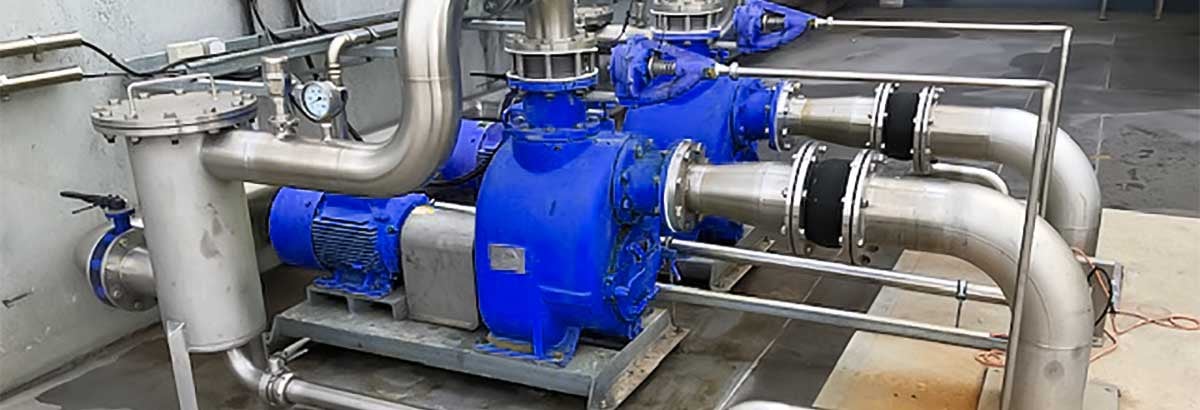Self-priming centrifugal pumps can be utilised in any application that standard centrifugal pumps are applied, but what makes them different is their ability to self-prime.
However, in certain circumstances, these pumps may be unable to self-prime. There are several occurrences that can cause this. In this blog, we discuss what self-priming pumps are and how to ensure yours continues operating efficiently and effectively.
What is a self-priming pump and how does it work?
Self-priming pumps are designed with an external casing that ‘floods’ the inner pump or volute. When the centrifugal pump is turned on, the impeller rotates counter clockwise, creating a low-pressure area in the eye of the impeller. As the pressure is lower than atmosphere, water is pushed up into the suction pipe by atmospheric pressure, which subsequently forces all the air in the suction line into the pump. The self-priming pump mixes the air with the recirculating water in the casing. As this occurs, the air separates from the liquid and discharges from the casing.
When all the air in the suction line is displaced, the pump delivers the flow like any other centrifugal pump.
When the self-priming pump is not working...
There are several reasons your self-priming pump may not be working, these include:
- There is an air leak in the suction line: While the fluid is recirculating in the pump, it forces air out of the discharge as it is trying to create an area of low pressure. However, if for some reason there is a leak in the suction line, air continues to be drawn into the pump, never allowing it to release enough to create the area of low pressure.
- Debris is in the impeller: If there is debris in the eye of the impeller, the hydraulic capabilities of the pump and impeller to create an area of low pressure is compromised. Effecting the pump from self-priming.
- The pump is air bound: If your pump is air bound, this means that it is filled with air and a vacuum can no longer be formed. Several scenarios can cause this, including:
- There is no air release line: When there is no air release line in the pump, air cannot be vented and instead collects on the discharge side.
-
- The discharge line is pressurised: This occurs when the valve on the air release line and discharge line is closed, giving no place for the air to travel out of the pump.
- There is excessive impeller clearance: When there is excessive clearance between the impeller and the wear plate, the pump can find it difficult to create a low-pressure area. This excessive clearance can be caused by wear or improper reassembly.
- There is a plugged recirculation port: During the initial priming process, fluid is recirculated through the volute casing. However, if the recirculation port becomes plugged, the eye of the impeller cannot create an area of low pressure. Therefore, the pump cannot pull the liquid into the suction line.
- The lift is too high for the pump’s speed or impeller diameter: If your pump is undersized for the suction line, it will not be able to create the low pressure required to prime. Therefore, it is important to understand the suction lift requirements before you select your pump.
- The lift is too high for the pump’s speed or impeller diameter: If your pump is undersized for the suction line, it will not be able to create the low pressure required to prime. Therefore, it is important to understand the suction lift requirements before you select your pump.
- Suction line is too long or there are too many bends: The suction line is the piping which transports your fluid material from its source to the pump itself. When your suction line is shorter, it ensures efficiency with less energy required to transport the fluid from one point to another. Ensuring your suction line is short or has less bends, guarantees the pump is operating efficiently and within its scope of capabilities. For self-priming pumps, it is crucial the suction piping is the same sizes as the pump suction. As there is added air volume if there is bigger suction lines, the self-priming pump will require more priming time. Therefore, it is important that your suction pipe rises to the pump, and not any higher - as to not allow for additional air and gases. It is also critical that the install piping is not smaller than the pump suction.
- The pump is running backwards: In some instances when installing a new pump or motor, replacing a motor, changing a stator or adding a VFD, the pump can run backwards. Before coupling the motor to the pump, it's recommended you run a test to ensure the shaft is turning the right way. There are three wires on the lead that connect the pump motor, these should be connected and then tested. If the test results show the wrong rotational direction, switch two of the three wires.
If the impeller is running backwards, it will only achieve 50% of the rated flow and, depending on the impeller specific speed (NS) it will generate 50% of the rated head.
Still can't seem to work out why your self-priming pump is not priming? Get in touch with Global Pumps! Whether you're needing assistance with your current self-priming pump, or want to learn more about this type of centrifugal pump, our team can discuss your application and advise.

